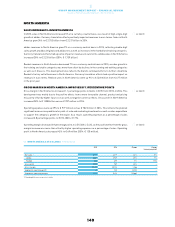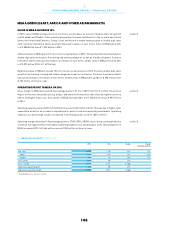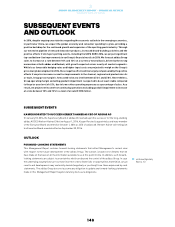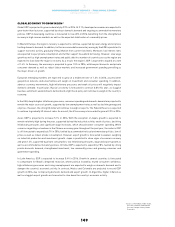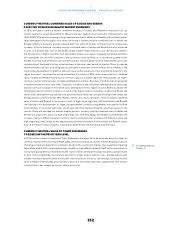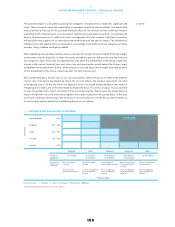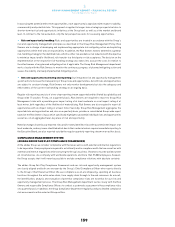Reebok 2015 Annual Report Download - page 153
Download and view the complete annual report
Please find page 153 of the 2015 Reebok annual report below. You can navigate through the pages in the report by either clicking on the pages listed below, or by using the keyword search tool below to find specific information within the annual report.GROUP MANAGEMENT REPORT – FINANCIAL REVIEW
Subsequent Events and Outlook
149
3
GLOBAL ECONOMY TO GROW IN 2016 1
Global GDP is projected to grow moderately by 2.9% in 2016. At 2.1%, developed economies are expected to
grow faster than last year, supported by robust domestic demand and ongoing accommodative monetary
policies. GDP in developing countries is forecasted to rise 4.8% in 2016, benefiting from the strengthened
recovery in high-income markets as well as the expected stabilisation of commodity prices.
In Western Europe, the region’s recovery is expected to continue, supported by lower energy and oil prices
fuelling domestic demand. In addition, further accommodative monetary easing by the ECB is predicted to
support economic activity, gradually lifting inflation from current low levels. Moreover, low interest rates
are expected to spur private consumption and further support household borrowing. However, slow wage
growth as well as high unemployment rates and public debt in a number of countries across the region are
expected to slow down the region’s recovery. As a result, the region’s GDP is expected to expand at a rate
of 1.4%. In Germany, the economy is projected to grow 1.5% in 2016, with buoyant domestic and private
consumer demand as well as robust labour markets and increased government spending prevailing as
the major drivers of growth.
European emerging markets are expected to grow at a moderate rate of 1.2% in 2016, as persistent
geopolitical tensions and uncertainties will weigh on investment and consumer spending. In addition,
adverse currency movements, high inflationary pressures and weak oil prices will negatively impact
domestic demand. In particular, Russia’s economy is forecasted to contract 0.8% this year, as sluggish
business sentiment, weak domestic demand and a tight fiscal policy will continue to weigh on the country’s
economy.
In the USA, despite higher inflationary pressures, consumer spending and domestic demand are projected to
remain the major source of growth, supported by low unemployment rates as well as declining energy and
oil prices. However, the strong US dollar will continue to weigh on exports. The Federal Reserve is expected
to continue to gradually lift interest rates. As a result, the US economy is forecasted to grow at 2.2% in 2016.
Asia’s GDP is projected to increase 5.1% in 2016. With the exception of Japan, growth is expected to
remain relatively high during the year, supported by healthy industrial activity, weak oil prices, declining
inflationary pressures and significant wage increases, which should bolster consumer spending. While
concerns regarding a slowdown in the Chinese economy grew throughout the past year, the nation’s GDP
is still forecasted to expand by 6.7% in 2016, fuelled by accommodative fiscal and monetary policies, low oil
prices as well as robust private consumption. However, export growth is forecasted to weaken, weighing
on industrial production and investment growth. Japan is predicted to show signs of economic recovery
and grow 1.2%, supported by private consumption, low inflationary pressures, wage and export growth as
well as accommodative monetary policies. In India, GDP is expected to expand by 7.8%, fuelled by strong
private domestic demand, strengthened investment, low commodity prices and growing consumer and
government spending.
In Latin America, GDP is expected to increase 0.4% in 2016. Growth in several countries is forecasted
to compensate for Brazil’s deepened recession, where political instability, muted consumer confidence,
high inflationary pressures and rising unemployment are expected to weigh on domestic demand and to
dampen the country’s economic activity. In contrast, Mexico and Colombia are projected to record GDP
growth in 2016, due to improving domestic demand and export growth. In Argentina, higher inflation as
well as sluggish export growth are forecasted to slow down the country’s economic activity.
1 Sources: World Bank, HSBC Global
Research, Namura Global Market
Research, Morgan Stanley Global
Economics.



